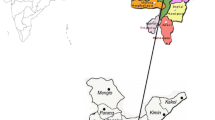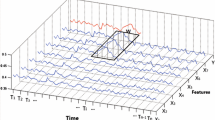Abstract
With the wavelet transform method, the multi-resolution analysis of runoff and sediment load at Huaxian hydrological station located in the lower reaches of the Weihe River in China is presented to find the varying quasic-periodic waveforms existing in different decomposed time scales. The cointegration theory is introduced to reveal the long-term balance relationship and short-term fluctuations of the original and decomposed runoff and sediment load time series. Thus, considering the decomposed sediment load components in different time scales as the input data series, and the corresponding decomposed runoff component acting as the output data series, the multi-resolution cointegration method is produced. The results show that the multi-resolution cointegration method has the higher prediction accuracy, and the prediction errors are almost less than 5 %.










Similar content being viewed by others
References
Abiyev RH (2011) Fuzzy wavelet neural network based on fuzzy clustering and gradient techniques for time series prediction. Neural Comput & Applic 20(2):249–259
Aman MK (2015) Wavelet genetic algorithm-support vector regression (wavelet GA-SVR) for monthly flow forecasting. Water Resour Manag 29(4):1283–1293
Braga ACFM, da Silva RM, Santos CAG, de Oliverira Galvão C, Nobre P (2013) Downscaling of a global climate model for estimation of runoff, sediment yield and dam storage: a case study of Pirapama basin. Brazil J Hydrol 498:46–58
Carriquiry JD, Sanchez A (1999) Sedimentation in the Colorado River delta and upper Gulf of California after nearly a century of discharge loss. Mar Geol 158:125–145
Compagnucci RH, Blanco SA, Figliola MA, Jacovkis PM (2000) Variability in subtropical Andean Argentinean Atuel fiver: a wavelet approach. Environmetrics 11:251–269
Dai SB, Lu XX (2014) Sediment load change in the Yangtze River (Changjiang): a review. Geomorphology 215:60–73
Engle RF, Granger CWJ (1987) Cointegration and error correction: representation, estimation and testing. Econometrica 55:251–276
Fanos AM (1995) The impact of human activities on the erosion and accretion of the Nile Delta coast. J Coast Res 11(3):821–833
Fukhrudin KM, Assefa MM, Patrick B, Karen BG (2013) Modeling the impact of land use changes on runoff and sediment yield in the Le Sueur watershed, Minnesota using GeoWEPP. Catena 107:35–45
Gaucherel C (2002) Use of wavelet transform for temporal characterization of remote watersheds. J Hydrol 269:101–121
Gebremicael TG, Mohamed YA, Betrie GD, van der Zaag P, Teferi E (2013) Trend analysis of runoff and sediment fluxes in the Upper Blue Nile basin: a combined analysis of statistical tests, physically-based models and landuse maps. J Hydrol 482:57–68
Han ZHY, Wei YM, Jiao YL, Fan Y, Zhang JT (2004) On the cointegration and causality between Chinese GDP and energy consumption. Syst Eng 22(12):17–21
He L, Huang GH, Zeng GM, Lu HW (2008) Wavelet-based multiresolution analysis for data cleaning and its application to water quality management system. Expert Syst Appl 35:1301–1310
Kulwinder SP, Rashmi B (2013) Wavelet and statistical analysis of river water quality parameters. Appl Math Comput 219:10172–10182
Mallat SG (1998) A wavelet tour of signal processing, 2nd edn. Academic, San Diego
Mu XM, Wang WL, Xu XX (1999) The influence of the soil and water conservation on the surface runoff in the watersheds in the gully plateau region of Loess Plateau. J Hydraul Eng (2):71–75
Sadeghi SHR, Seghaleh Bashari M, Rangavar AS (2013) Plot sizes dependency of runoff and sediment yield estimates from a small watershed. Catena 102:55–61
Seung-Hoon Y (2007) Urban water consumption and regional economic growth: the case of Taejeon, Korea. Water Resour Manag 21:1353–1361
Shi CHX, Zhou YY, Fan XL, Shao WW (2012) A study on the annual runoff changes and its relationship with water and soil conservation practices and climate changes in the middle Yellow River basin. Catena 100:31–41
Venkata Ramana R, Krishna B, Kumar SR, Pandey NG (2013) Monthly rainfall prediction using wavelet neural network analysis. Water Resour Manag 27:3697–3711
Wang XY, Zhao XP, Liu ZW, Dong SQ (2011) Research on lake eutrophication predictioning methods based on grey theory. Comput Simul 28(1):17–19
Xu LQ, Liu SHY (2013) Study of short-term water quality prediction model based on wavelet neural network. Math Comput Model 58:807–813
Xu JX, Sun J (2003) Influence of precipitation and human activities on water fluxes from the Yellow River into the sea in the past 50 years. Adv Water Sci 14(6):690–695
Yilmaz S, Oysal Y (2010) Fuzzy wavelet neural network models for prediction and identification of dynamical systems. IEEE Trans Neural Netw 21(10):1599–1609
Zhang LY, Zhang LP, Cao FL, Song XY (2006a) Annual runoff forecasting research based on the theory of cointegration and error correction model. Eng J Wuhan Univ 39(6):6–11
Zhang Q, Xu CHY, Becker S, Jiang T (2006b) Sediment and runoff changes in the Yangtze River basin during past 50 years. J Hydrol 331:511–523
Zhang Y, Xu JH, Lu GG (2008) Dynamic analysis of water footprint and resources utility efficiency of Xinjiang in northwest of China arid areas. J Desert Res 28(4):775–783
Zhang XM, Cao WH, Yu XX, Wu SH (2009) Effect of LUCC on runoff regulation in watershed in loess gullied-hilly region of China. J Hydraul Eng 40(6):641–650
Zhang JP, Ding ZHH, Yuan WL, Zuo QT (2013) Research on the relationship between rainfall and reference crop evapotranspiration with multi-time scales. Paddy Water Environ 11:473–482
Zhang JP, Zhao Y, Ding ZHH (2014a) Research on the relationships between rainfall and meteorological yield in irrigation district. Water Resour Manag 28:1689–1702
Zhang X, Yu GQ, Li ZHB, Li P (2014b) Experimental study on slope runoff, erosion and sediment under different vegetation types. Water Resour Manag 28(9):2415–2433
Zhao FF, Xu ZX (2009) Hydrological response to climate change in headwater catchment of the Yellow River Basin. Res Sci 31(5):722–730
Zhao RR, Chen HC, Zhu SL, Zhao LQ (2007) Analysis on variations of runoff and reasons of headwater region of the Yellow River. Yellow River 29(4):15–16
Acknowledgments
This research is supported by the National Natural Sciences Foundation of China (Project No. 51309202, 51379216) and Open Laboratory of Science and Water Conservancy of Key Disciplines in Henan Province, and also by Program for Innovative Research Team (in Science and Technology) in University of Henan Province (No. 13IRTSTHN030).
Compliance with Ethical Standards
The authors declare that they have no conflict of interest. All procedures performed in studies involving human participants were in accordance with the ethical standards of the institutional and/or national research committee. This article does not contain any studies performed by any of the authors. Informed consent was obtained from all individual participants included in the study.
Author information
Authors and Affiliations
Corresponding author
Rights and permissions
About this article
Cite this article
Zhang, J., Zhao, Y. & Xiao, W. Multi-Resolution Cointegration Prediction for Runoff and Sediment Load. Water Resour Manage 29, 3601–3613 (2015). https://doi.org/10.1007/s11269-015-1018-7
Received:
Accepted:
Published:
Issue Date:
DOI: https://doi.org/10.1007/s11269-015-1018-7




